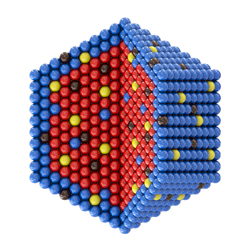'Invisible ink' that's not just for kids
The field of optics relies on manipulating electromagnetic (EM) radiation – light of various frequencies and wavelengths. The development of metamaterials in recent years has created a new class of artificially structured composite materials with unforeseen EM properties. These properties emerge largely due to fabricated inhomogeneities of dimensions much smaller than the wavelength of interest, typically nanometres for the visible light range. Such structures result in resonance – synchronous oscillation at the natural frequency of a material leading to large-amplitude oscillations. Scientists initiated the EU-funded project 'Self-organized nanomaterials for tailored optical and electrical properties' (Nanogold) to design materials with high potential for producing an effective negative refractive index. Investigators identified readily available metal nanoparticles (NPs) capable of self-assembly into meta-atoms with well defined geometry in order to form a composite material. NPs were introduced into liquid-crystal molecules capable of self-organisation. Structure was controlled using external sources such as temperature, electric field or light to produce collective resonance of the nano-inclusions. The scientists then developed low-resolution crystallography methods to determine the nanostructures of self-assembled metamaterials. Using a bottom-up approach for the fabrication of metamaterials, Nanogold developed a material for an imaging device with resolution outperforming conventional microscopes by several orders of magnitude. Scientists also developed materials that conceal objects from an external observer as well as others that completely absorb light across a broad spectral range. In the latter, the absorbed light was converted into heat that could be used in nano-scale catalytic or thermo-photovoltaic applications. All these advances were accomplished using an ink easily and inexpensively fabricated in large quantities for deposition on arbitrary objects. In the long run, materials capable of being processed at room temperatures will enable fabrication using the well established plastics processing chain, including injection moulding and hot embossing. Using resonance and interference via periodic structures on the nano scale to tune EM properties, scientists have delivered bulk optical metamaterials operating in spectral domains appropriate for innovative photonics applications. 'The building blocks of metamaterials' can be downloaded from the project website at http://nanogold.epfl.ch(opens in new window).







